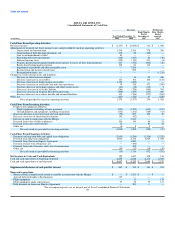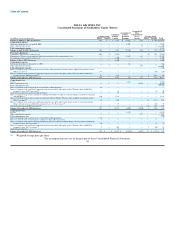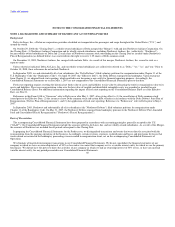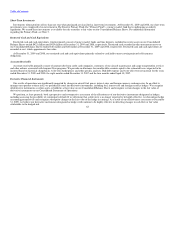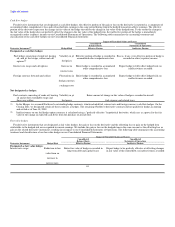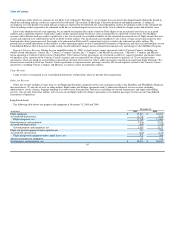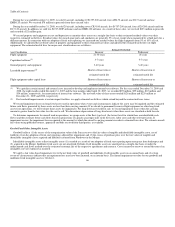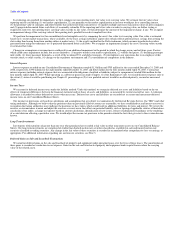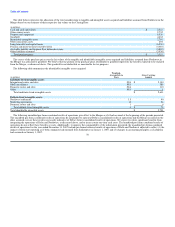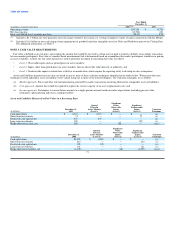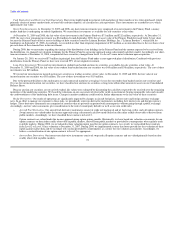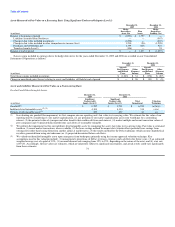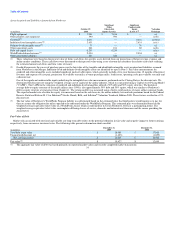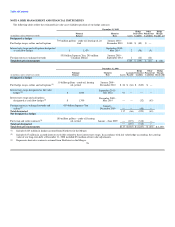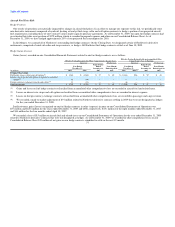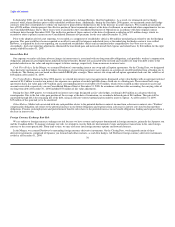Delta Airlines 2009 Annual Report Download - page 73
Download and view the complete annual report
Please find page 73 of the 2009 Delta Airlines annual report below. You can navigate through the pages in the report by either clicking on the pages listed below, or by using the keyword search tool below to find specific information within the annual report.
Table of Contents
Manufacturers' Credits
We periodically receive credits in connection with the acquisition of aircraft and engines. These credits are deferred until the aircraft and engines are
delivered, and then applied on a pro rata basis as a reduction to the cost of the related equipment.
Maintenance Costs
We record maintenance costs to aircraft maintenance materials and outside repairs on our Consolidated Statements of Operations. Maintenance costs are
expensed as incurred, except for costs incurred under power-by-the-hour contracts, which are expensed based on actual hours flown. Power-by-the-hour
contracts transfer certain risk to third party service providers and fix the amount we pay per flight hour to the service provider in exchange for maintenance
and repairs under a predefined maintenance program. Modifications that enhance the operating performance or extend the useful lives of airframes or engines
are capitalized and amortized over the remaining estimated useful life of the asset or the remaining lease term, whichever is shorter.
Inventories
Inventories of expendable parts related to flight equipment are carried at moving average cost and charged to operations as consumed. An allowance for
obsolescence is provided over the remaining useful life of the related fleet for spare parts expected to be available at the date aircraft are retired from service.
We also provide allowances for parts identified as excess or obsolete to reduce the carrying costs to the lower of cost or net realizable value. These parts are
assumed to have an estimated residual value of 5% of the original cost. In connection with our adoption of fresh start reporting upon emergence from
bankruptcy, we recorded our expendable parts inventories at fair value.
Advertising Costs
We expense advertising costs as other selling expenses in the year incurred. Advertising expense was $176 million and $114 million for the years ended
December 31, 2009 and 2008, respectively, $121 million for the eight months ended December 31, 2007 and $51 million for the four months ended April 30,
2007.
Commissions
We record passenger commissions in prepaid expenses and other on our Consolidated Balance Sheets when the related passenger tickets are sold.
Passenger commissions are recognized in operating expense on our Consolidated Statements of Operations when the related revenue is recognized.
Stock-Based Compensation
We measure the cost of employee services in exchange for an award of equity instruments based on the grant-date fair value of the award. The fair value of
our stock options is estimated using an option pricing model. The cost of equity awards granted to employees is recognized over the period during which an
employee is required to provide service in exchange for the award (usually the vesting period of the award).
Reclassifications
We reclassified certain prior period amounts, none of which were material, to conform to our current period presentation. The reclassifications to the
Consolidated Statements of Cash Flow were within cash flows from operating activities and do not impact total net cash provided by or used in operating
activities for any period. The adjustments to the Consolidated Statements of Operations do not impact total operating expense or net income for any period.
We reclassified travel and incidental expenses, primarily crew meals and lodging expenses, from salaries and related costs to other operating expense.
These expenses amount to $308 million for the year ended December 31, 2008, $173 million for the eight months ended December 31, 2007 and $82 million
for the four months ended April 30, 2007. We also adjusted our Consolidated Statements of Operations for certain costs incurred to provide services to our
Contract Carriers, excluding Comair, Compass and Mesaba; these costs are recorded as a reduction to salaries and related costs and contracted services, as
appropriate, rather than as a reduction to other operating expense. These costs amount to $256 million for the year ended December 31, 2008, $181 million for
the eight months ended December 31, 2007 and $80 million for the four months ended April 30, 2007.
68


